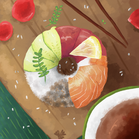Culture of Esonice
The culture of Esonice is the product of millennia's of change and growth, influenced by many factors such as geography, history, and absorbing influences from other cultures that had an impact on the Esonian people: such as Huang culture, Proto-Buranian culture, the old Horse Lords culture, and in more recent times, Europan and Iverican cultures. To a lesser extent, Heiheren culture, Ketek and some other Paran cultures also had an impact on Esonian culture and society historically.
It is theorised that Esonian culture is a result of the old native Yano culture intermixing and integrating the proto-Buranians that migrated across the Oriental ocean, and invaded Esonice, settling in Kumiko and Velisia and by the 6th century BC, creating pre-Horse Lord invasion old Esonian culture. It is estimated that the modern inhabitants of Esonice share around 20 to 35% of their genetic make-up to the proto-Buranians that came to Esonice. Variations of Esonian culture include Velisian, Yatosan, Hirumese, Alodian, Juraban, Chiyashan, Kumikan and Emisan: all of which have their own cultural traditions and quirks. 67 official dialects of Esonian have been identified in Esonice which vary in distinction from each other, with some more related to each other than the others.
People of Esonice quite often experienced periods of isolation from the rest of the wurld, often because of its geographic position due to the Paran desert or because of rulers deciding to close the country. Esonice's most recent isolationist period was during the 18th and early 19th century until the beginning of Tagmantine Holy War and the Esonian revolution. This resulted in Esonian society often taking different routes that allowed for unique developments of Esonian culture. Today Esonice stands as a highly developed that upholds its cultural heritage strongly, with it being admired by many.

